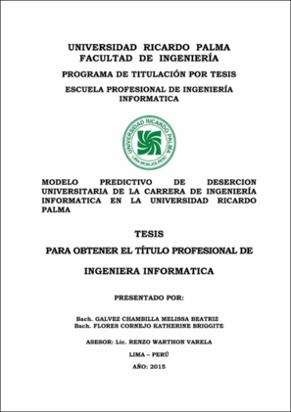Mostrar el registro sencillo del ítem
Modelo predictivo de deserción universitaria de la carrera de Ingeniería Informática en la Universidad Ricardo Palma.
| dc.contributor.advisor | Warthon Varela, Renzo | |
| dc.contributor.author | Gálvez Chambilla, Melissa Beatriz | |
| dc.contributor.author | Flores Cornejo, Katherine Briggite | |
| dc.date.accessioned | 2019-07-22T17:21:30Z | |
| dc.date.available | 2019-07-22T17:21:30Z | |
| dc.date.issued | 2015 | |
| dc.identifier.uri | https://hdl.handle.net/20.500.14138/2031 | |
| dc.description.abstract | La deserción universitaria se ha convertido en un problema importante a ser investigado. La tasa de deserción ha llegado a constituir uno de los principales indicadores de eficiencia interna dentro de cualquier institución de educación. Investigar las causas de la deserción con metodologías adecuadas que permitan predecir esta, contribuye a la toma de decisiones dentro de la gestión de la unidad académica. El objetivo del presente proyecto consiste en investigar y proponer una metodología que permita identificar en forma automática a los estudiantes con mayor riesgo de deserción de las carreras de Ingeniería Informática en la Universidad Ricardo Palma. Para la implementación de este proyecto se adoptó la metodología CRISP-DM que estructura el proceso de minería de datos en seis fases, que interactúan entre ellas de forma iterativa. Se evaluaron los modelos de Árboles de decisión y Clustering para analizar el comportamiento de los estudiantes, evaluando factores como el rendimiento del alumno, condición social y aspectos socioeconómicos. La exactitud de los modelos es calculada a partir de la información que brindó la Oficina Central de Informática y Cómputo de la Universidad Ricardo Palma, en la cual se realizó una transformación y simulación de algunas variables para mayor efectividad del modelo. The college desertion has become an important problem to be investigated. The desertion rate has come to be one of the main indicators of internal efficiency in any educational institution. The research of the causes of desertion with appropriate methodologies to predict, contributes to decision making in the academic management The objective of this project is to investigate and propose a methodology to automatically identify students at high risk of dropping out of the Computer Engineering career at the Ricardo Palma University. To implement this project, we used the CRISP-DM methodology to structure the data mining process into six phases, which interact with each other iteratively. It was applied the models of decision trees and clustering to analyze the behavior of the students, evaluating factors such as student performance, social status and socio-economic aspects. The accuracy of the models is calculated from the information provided the Central Office of Information and Computation at the Ricardo Palma University, in which it was applied a transformation and simulation of some variables for greater effectiveness and performance of the model. | es_ES |
| dc.description.sponsorship | Submitted by Robert Alexander Campos Rivas (robert.c.rivas@gmail.com) on 2019-07-22T17:21:30Z No. of bitstreams: 1 flores_kb-galvez_mb.pdf: 1779851 bytes, checksum: 589cd678c15cb494b96917f62a6086bf (MD5) | es_ES |
| dc.description.sponsorship | Made available in DSpace on 2019-07-22T17:21:30Z (GMT). No. of bitstreams: 1 flores_kb-galvez_mb.pdf: 1779851 bytes, checksum: 589cd678c15cb494b96917f62a6086bf (MD5) Previous issue date: 2015 | es_ES |
| dc.description.uri | Tesis | es_ES |
| dc.format | application/pdf | |
| dc.language.iso | spa | |
| dc.publisher | Universidad Ricardo Palma - URP | es_ES |
| dc.rights | info:eu-repo/semantics/openAccess | |
| dc.rights.uri | https://creativecommons.org/licenses/by-nc-nd/4.0/ | |
| dc.source | Repositorio Institucional - URP | es_ES |
| dc.subject | Deserción universitaria | es_ES |
| dc.subject | Minería de datos | es_ES |
| dc.subject | Modelo predictivo | es_ES |
| dc.subject | Árbol de decisión | es_ES |
| dc.subject | Desertion University | es_ES |
| dc.subject | Data Mining | es_ES |
| dc.subject | Predictive Model | es_ES |
| dc.subject | Decision tree | es_ES |
| dc.title | Modelo predictivo de deserción universitaria de la carrera de Ingeniería Informática en la Universidad Ricardo Palma. | es_ES |
| dc.type | info:eu-repo/semantics/bachelorThesis | |
| thesis.degree.discipline | Ingeniería Informática | es_ES |
| thesis.degree.grantor | Universidad Ricardo Palma. Facultad de Ingeniería. Escuela Profesional de Ingeniería Informática | es_ES |
| thesis.degree.level | Título Profesional | es_ES |
| thesis.degree.program | Programa de Titulación por Tesis | es_ES |
| thesis.degree.name | Ingeniera Informático | es_ES |
| dc.publisher.country | PE | es_ES |
| dc.subject.ocde | https://purl.org/pe-repo/ocde/ford#2.11.02 | |
| renati.type | https://purl.org/pe-repo/renati/type#tesis | |
| renati.level | https://purl.org/pe-repo/renati/nivel#tituloProfesional | |
| renati.discipline | 612286 | |
| dc.type.version | info:eu-repo/semantics/publishedVersion |
Ficheros en el ítem
Este ítem aparece en la(s) siguiente(s) colección(ones)
-
Ingeniería Informática [137]


